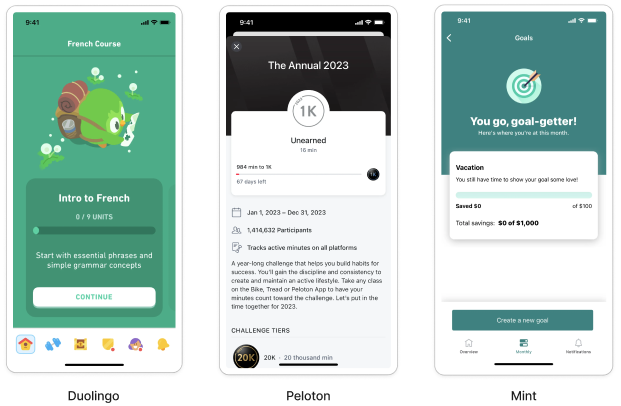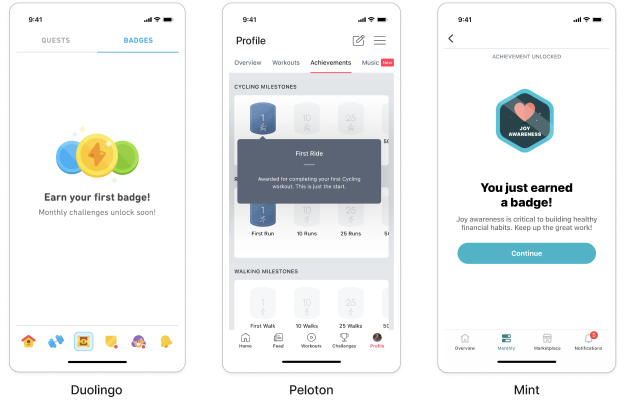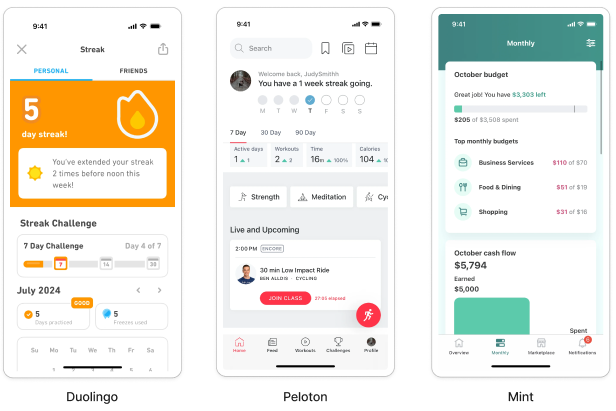What budgeting apps, Peloton, and Duolingo have in
common
The psychology behind what makes a successful, habit-building application.

And why they’re so addictive.
I’ve just started working for a budgeting app. Tiny problem: budgeting has never been my thing. I mean, my financial strategy until now has been “try not to look at my account balance too often.” But here I am, surrounded by spending charts, savings trackers, and financial goals. At first, all these budgeting apps — like Mint, YNAB, and Cleo — seemed to offer different vibes. Cleo, with its Gen-Z flair, even has a pizza cursor on its website; meanwhile, Mint looks sleek and professional, practically begging you to get serious about your money.
But once I got past the different looks, I realized they all felt surprisingly familiar. Despite my lack of budgeting experience, I wasn’t totally lost. Why? Because I’ve spent years using apps that nudge me to build habits — fitness apps to get me off the couch, Duolingo to keep my Spanish from gathering dust, and more. And they all rely on the same psychological trick for habit-building. These apps don’t just track things — they encourage you to keep coming back. It’s all built on a model called the Hook Model, which uses four key stages to keep you engaged: Cue, Action, Reward, and Investment.
So, let’s break down this model using three very different apps — Duolingo (language learning), Peloton (fitness), and Mint (budgeting). We’ll see how they use the Hook Model to get you invested in habit-forming journeys, even if you’re just trying not to snooze your morning alarm.
The Hook model: how apps make habits stick
At the heart of habit-building is the Hook Model, a framework for designing habits that keep us coming back. It works in four simple stages:
1. Cue — This is the trigger or prompt that nudges you to start the habit. A cue reminds you to log back in, take action, or stay consistent.
2. Action — Once you’re hooked by the cue, the app prompts you to take a small, achievable step, whether it’s logging an expense or doing a quick workout.
3. Reward — After the action, you get a little dopamine boost — often in the form of a badge, streak, or encouraging message. This keeps you coming back because it feels good to win, even in small ways.
4. Investment — Over time, the app tracks your progress, showing you how far you’ve come and motivating you to keep going. This is where your actions start to feel like a long-term commitment, encouraging you to stick with the habit.
Now, let’s see how this model plays out in three wildly different apps.
Cue: Setting up the challenge

Everything starts with a challenge
The first stage in the Hook Model is the cue — that initial nudge to start a habit. Each of these apps has a different way of pulling you in, but the strategy is the same: set up a challenge and prompt users to get started.
• Duolingo: Every day, Duolingo sends you that dreaded “You’re going to lose your streak!” notification. It’s a small but powerful reminder that plays on your sense of consistency. The “daily challenge” becomes hard to resist because you don’t want to lose the progress you’ve already made.
• Peloton: Peloton hooks you with “challenges” that get you to commit to a regular workout routine. These challenges often have clear, time-bound goals like “10 days of cardio,” which are tough to ignore once you’ve signed up.
• Mint: Mint’s approach to cues is very similar with a challenge to change you spend less in a given category. By simply bringing your attention to your finances, Mint primes you to think about budgeting as a habit.
Each cue is different, but all of them are designed to start you on a habit-building journey.
Action: Taking small steps with progress bars

Users are then gently primed to take small steps with a progress bar
Once you’re primed with a cue, the next step in the Hook Model is the action — a simple, achievable step that makes it easy for users to engage. Often, this action is linked to a progress bar, which encourages you to keep going to “finish the job.” This taps into a cognitive bias known as the Zeigarnik Effect, which states that humans are more likely to remember unfinished tasks and feel compelled to complete them.
• Duolingo: Duolingo shows you a progress bar that tracks how many lessons you’ve completed, pushing you to reach the “finish line” and keep your streak alive. The “almost there!” bar makes you want to complete it just for the satisfaction of seeing it filled.
• Peloton: In Peloton, every workout adds to a tally that shows your cumulative progress. By visually marking your achievements, Peloton encourages you to complete a session even on lazy days because it gets you one step closer to your overall fitness goal.
• Mint: Mint’s progress bar is more subtle, but it’s there in the form of monthly spending summaries and goals. Seeing your progress on a goal like “Save $500 this month” turns the abstract idea of saving into something tangible, encouraging you to take those extra actions toward financial health.
These tiny, achievable actions help you get invested and keep coming back, thanks to that itch for completion.
Reward: The power of random badges

When completing an action, users are given a reward: badges, gems etc
Every habit needs a reward, and apps are masters at dishing these out. Badges, streaks, or congratulatory messages may seem trivial, but they’re actually powerful reinforcers. They tap into our love for unexpected rewards — a psychological concept known as variable rewards. This randomness can make the experience more exciting and enjoyable, as you’re never quite sure when the next reward will come.
• Duolingo: Duolingo gives you random badges for everything from language milestones to daily streaks, and it’s surprisingly addictive. These small wins give you a dopamine boost, making you feel like you’re achieving something with every login.
• Peloton: Peloton hands out badges for every kind of workout milestone, from your “first ride” to “five-day streaks.” You get a little rush with each badge, even if it feels random, which keeps you coming back for more.
• Mint: Mint’s rewards are a bit different. Instead of badges, it’s about visualizing progress with charts and graphs. Mint celebrates every time you’re “under budget” or reach a new savings milestone, making you feel accomplished — even if it’s just avoiding a few extra expenses.
These rewards feel random enough to keep you guessing, making every action feel like it might lead to a little victory.
Investment: Long-term tracking for lasting motivation

A dashboard highlights how much progress a user has done and how much is left
The final stage, investment, is where the app really solidifies its place in your life. This is the part that keeps you around for the long haul by showing your progress over time. Investment features typically include dashboards or summaries that remind you how far you’ve come, giving you a sense of long-term achievement.
• Duolingo: Duolingo’s language levels and streak counts remind you of how much effort you’ve put in, making it harder to quit because you don’t want to lose your progress.
• Peloton: Peloton’s workout history shows you every ride, run, or workout you’ve completed. This tracker gives you a sense of accomplishment, making you feel like you’ve built up something worth continuing.
• Mint: Mint’s dashboard is all about the long-term view, showing you charts of spending over months and years. It’s a subtle way to encourage consistency, as you start to see patterns and trends in your spending and savings.
Each app’s investment features help you feel like you’re building toward something meaningful, increasing your commitment and making it harder to walk away.
The power — and pitfall — of habit-building apps
In the end, it’s fascinating to see how budgeting apps like Mint use the same habit-building strategies as fitness and language apps. By following the Hook Model — Cue, Action, Reward, Investment — these apps turn daunting goals into manageable daily tasks, making budgeting, exercising, and learning languages feel natural.
But here’s the catch: while these techniques are powerful for building positive habits, they can also lead to “app fatigue” over time. When every app in your life is trying to build a habit, it can feel overwhelming to keep up with all the reminders, badges, and progress bars. Still, if you’re trying to make a positive change, these apps show just how effective habit-building can be.
So, whether it’s budgeting, working out, or learning a new language, remember that building better habits is a journey. And with the right app nudges, you might just find yourself sticking to those good habits without even realizing it.
For more content like this, follow Angèle on LinkedIn.
This article was originally published here.

Wow, I'm just a beginner looking to start an Edtech company and I found this very helpful. Thank you